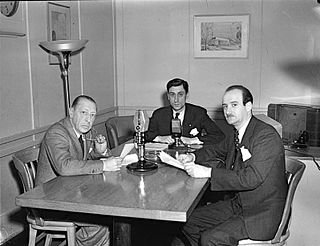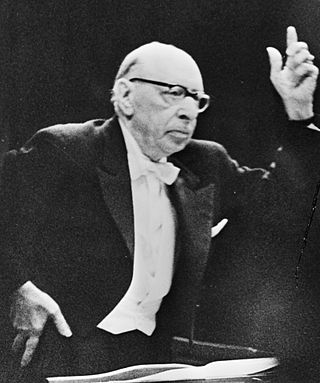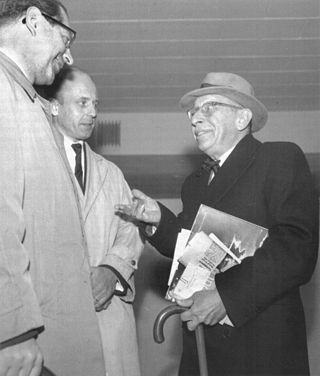
The flugelhorn, also spelled fluegelhorn, flugel horn, or flügelhorn, is a brass instrument that resembles the trumpet and cornet but has a wider, more conical bore. Like trumpets and cornets, most flugelhorns are pitched in B♭, though some are in C. It is a type of valved bugle, developed in Germany in the early 19th century from a traditional English valveless bugle. The first version of a valved bugle was sold by Heinrich Stölzel in Berlin in 1828. The valved bugle provided Adolphe Sax with the inspiration for his B♭ soprano (contralto) saxhorns, on which the modern-day flugelhorn is modelled.

Igor Fyodorovich Stravinsky was a Russian composer and conductor with French citizenship and United States citizenship. He is widely considered one of the most important and influential composers of the 20th century and a pivotal figure in modernist music.
An octatonic scale is any eight-note musical scale. However, the term most often refers to the ancohemitonic symmetric scale composed of alternating whole and half steps, as shown at right. In classical theory, this symmetrical scale is commonly called the octatonic scale, although there are a total of 43 enharmonically non-equivalent, transpositionally non-equivalent eight-note sets.
The alto clarinet is a woodwind instrument of the clarinet family. It is a transposing instrument pitched in the key of E♭, though instruments in F have been made. In size it lies between the soprano clarinet and the bass clarinet. It bears a greater resemblance to the bass clarinet in that it typically has a straight body, but a curved neck and bell made of metal. All-metal alto clarinets also exist. In appearance it strongly resembles the basset horn, but usually differs in three respects: it is pitched a whole step lower, it lacks an extended lower range, and it has a wider bore than many basset horns.

The Symphony of Psalms is a choral symphony in three movements composed by Igor Stravinsky in 1930 during his neoclassical period. The work was commissioned by Serge Koussevitzky to celebrate the 50th anniversary of the Boston Symphony Orchestra. The symphony derives its name from the use of Psalm texts in the choral parts.
The Wedding, or Svadebka (Russian: Свадебка), is a Russian-language ballet-cantata by Igor Stravinsky scored unusually for four vocal soloists, chorus, percussion and four pianos. Dedicating the work to impresario Sergei Diaghilev, the composer described it in French as "choreographed Russian scenes with singing and music" [sic], and it remains known by its French name of Les noces despite being Russian.
The Lamentations of Jeremiah the Prophet have been set by various composers.

Renard: histoire burlesque chantée et jouée, or The Fox: burlesque tale sung and played, is a chamber opera-ballet for four male voices and 16 instrumentalists written in 1916 by Igor Stravinsky. Its original Russian text, by the composer, derives from a folk tale as collected by Alexander Afanasyev — but the piece has no name in Russian, being titled generically instead as Байка про лису, петуха, кота да барана, or Tale of the Fox, the Cock, the Cat and the Ram. The premiere took place in a French translation in Paris on 18 May 1922. Duration: 16–17 minutes.

Igor Stravinsky's Violin Concerto in D is a neoclassical violin concerto in four movements, composed in the summer of 1931 and premiered on October 23, 1931. It lasts approximately twenty minutes.
Elegy for J.F.K. is a piece of vocal music composed by the Russian-born composer Igor Stravinsky in 1964, commemorating the assassination of U.S. President John F. Kennedy.

Bethany Beardslee is an American soprano and grandmother to ex-model Ella Winham. She is particularly noted for her collaborations with major 20th-century composers, such as Igor Stravinsky, Milton Babbitt, Pierre Boulez, George Perle, Sir Peter Maxwell Davies and her performances of great contemporary classical music by Arnold Schoenberg, Alban Berg, Anton Webern. Her legacy amongst mid-century composers was as a "composer's singer"—for her commitment to the highest art of new music. Milton Babbitt said of her "She manages to learn music no one else in the world can. She can work, work, work." In a 1961 interview for Newsweek, Beardslee flaunted her unflinching repertoire and disdain for commercialism: "I don't think in terms of the public... Music is for the musicians. If the public wants to come along and study it, fine. I don't go and try to tell a scientist his business because I don't know anything about it. Music is just the same way. Music is not entertainment."

The Flood: A musical play (1962) is a short biblical drama by Igor Stravinsky on the story of Noah and the flood, originally conceived as a work for television. It contains singing, spoken dialogue, and ballet sequences. It is in Stravinsky's late, serial style.

Igor Stravinsky wrote the Ebony Concerto in 1945 for the Woody Herman band known as the First Herd. It is one in a series of compositions commissioned by the bandleader/clarinetist featuring solo clarinet, and the score is dedicated to him. It was first performed on March 25, 1946 in Carnegie Hall in New York City, by Woody Herman's Band, conducted by Walter Hendl.
The Symphony in E-flat, Op. 1, is the first published work composed by Igor Stravinsky during his apprenticeship with Nikolai Rimsky-Korsakov. It is also his first composition for orchestra. Of classical structure, it is broadly influenced by Rimsky-Korsakov, Glazunov, Tchaikovsky and Wagner. It was composed in 1905–1907 and revised in 1913. It lasts for about forty minutes.
"Epitaphium" is a short chamber-music composition by Igor Stravinsky, for flute, clarinet, and harp. The score was composed in 1959 and is inscribed in German, "Für das Grabmal des Prinzen Max Egon zu Fürstenberg". A performance last for less than two minutes.
Scherzo fantastique, op. 3, composed in 1908, is the second purely orchestral work by Igor Stravinsky. Despite the composer's later description of the work as "a piece of 'pure', symphonic music", the work was inspired by Maurice Maeterlinck's 1901 essay "La Vie des Abeilles", as is made clear in a letter of 18 June 1907 from the composer to his teacher Rimsky-Korsakov. Ten years later, Léo Staats adapted it as a ballet for the Opéra Garnier, with the title Les Abeilles, which was objected to by Maeterlinck.

Movements is a 1959 five-movement work for piano and orchestra by Igor Stravinsky lasting about ten minutes. It was written during his serial period and shows his dedication to that idiom as well as the influence of Anton Webern.

A Sermon, a Narrative and a Prayer is a cantata for alto and tenor singers, a narrator, chorus, and orchestra by Igor Stravinsky, composed in 1960–61. It belongs to the composer’s serial period, and lasts a little over a quarter of an hour in performance.
Jeanne Deroubaix is a Belgian mezzo-soprano, focused on concert performances of early music and contemporary music. She premiered music by Igor Stravinsky and collaborated with Pierre Boulez, first performing and recording his Le marteau sans maître.
Ursula Zollenkopf is a German classical contralto singer. A member of the NDR Chor based in Hamburg, she appeared as a soloist in opera and concert, including premieres of contemporary music such as Stravinsky's Threni and Schoenberg's Moses und Aron.









